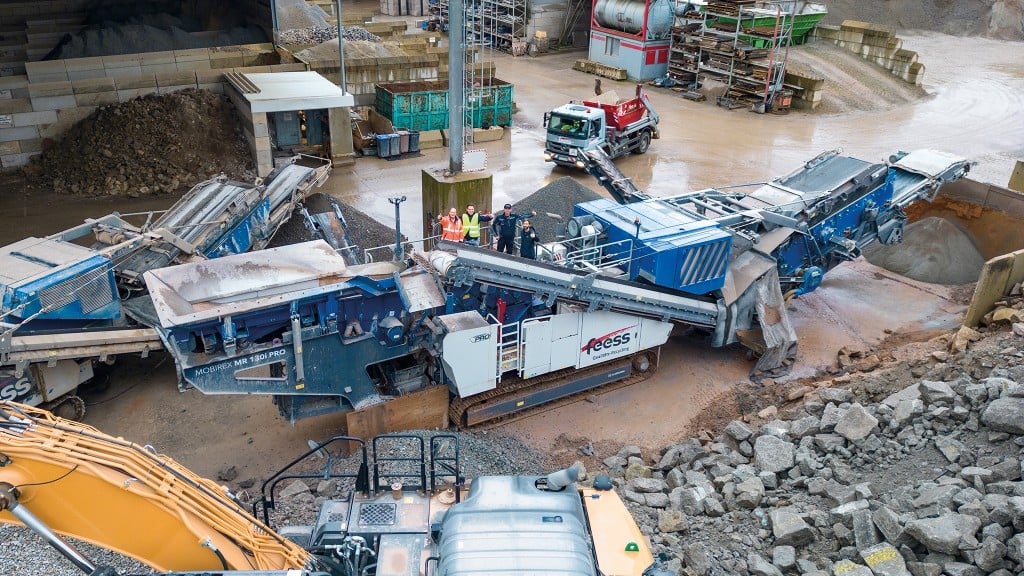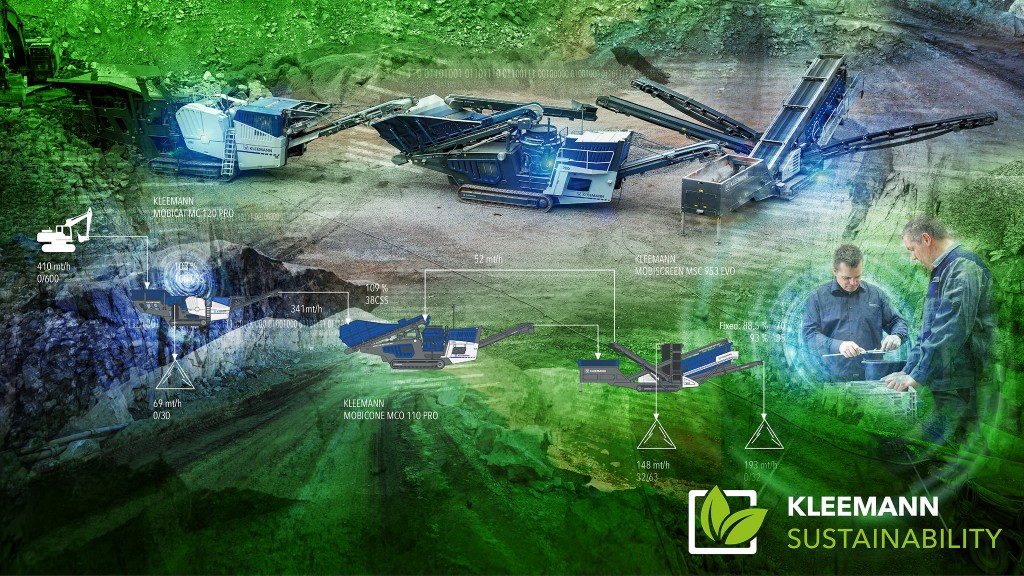
Feess, a German family-owned company, has long been a promoter of established and rigorously implemented recycling management approaches in coordination with government, politicians, and others. It even runs an in-house training centre where interested parties can learn more about the potential of contemporary construction material recycling.
An important component in the overall recycling process is the Kleemann MOBIREX PRO MR 130i mobile impact crusher. Feess tested the plant at the end of the development phase, and were so impressed they decided to keep it. Upgraded to serial production standard, the plant now plays an important role in the company's overall operations, which are climate and environmentally friendly.
Walter Feess, CEO and plant operator Waldemar Rollheiser, shared their views on recycling management and discussed the MOBIREX MR 130i PRO.
You have further expanded your business's recycling activities in recent years. What areas have you prioritized?
Walter Feess: Construction and demolition wastes are a huge factor in the overall volume of waste generated - they make up over 50 percent of the total waste produced in Germany. At present, high-quality mineral construction resources are dumped in landfill sites every day or are at most utilized as materials for sub-bases or filling. This is an incredible waste of valuable resources that we are making every effort to prevent. We return large amounts of construction materials to the cycle.
With the MOBIREX MR 130i PRO mobile impact crusher from Kleemann, we process concrete demolition material and mixed rubble to produce materials such as mineral aggregates for R concrete. Around 40 percent of recycled aggregates can be added to concrete without any disadvantages with regard to processing, appearance, haptics, and strength. Unfortunately, the material is rarely used by architects and civil engineers - simply because it is still relatively unknown. Changing this situation is one of the points we focus on in our training centre: We want to make professional users aware of the quality of R concrete and the amazing opportunities it offers - not to mention the enormous reductions of CO2 emissions it makes possible, with which we make an important contribution to the fight against climate change.
That sounds as if you have a more ambitious goal than simple profit optimization.
Feess: It's clear that we have to act now. There is no point in merely talking about having to get a grip on CO₂ emissions. We owe it to our children and grandchildren to take action now and create corresponding legal and normative bases. But the great thing is that: We already have the capabilities, the technology, and the expertise - all we have to do is use them. With this in mind I have actually set my sights on the more ambitious goal and will never tire of appealing not only to architects and engineers, but also to local authorities and administrative bodies. As a recycling company, for example, it is incredibly difficult to get the space we need. Short paths in the materials recycling process would enable us to significantly reduce long transport distances and the associated CO₂ emissions.
Our company was awarded the contract for the deconstruction of a district administration office in the region. On that project, we were able to return over 90 percent of the materials to the construction cycle.
More specifically, this meant that the aggregate for the R concrete for the new district administration office was produced from the construction materials reclaimed from the old building. In other words, we turned old into new. The largest proportion of the mineral construction materials was crushed directly on the construction site or at our recycling depots at a rate of up to 1,800 tons a day. The experience we gathered here is something I'd like to pass on, including to our competitors. The change can only happen if we all pull together. Apart from that, this procedure is not necessarily more expensive. Fuel and material prices will continue to increase due to scarcity and the CO2 tax. Therefore, recycling processes will also have financial benefits in the long run. To me, it is perfectly clear that we will not be able to achieve our environmental goals without a narrower focus on the establishment of strong recycling management.
You are using the new MOBIREX MR 130i PRO mobile impact crusher from Kleemann for materials processing. Were you impressed by the plant from the outset?
Feess: The overall concept of the plant appealed to us right away. The low fuel consumption, the high output, and the extremely efficient double-deck post-screening unit. Space is at a premium here, and with this plant we get two machines in one. We used to use a crushing plant followed by a separate screening plant - now, thanks to the high performance and the ability to discharge two classified final products, the MR 130i PRO is just what we need. It also means that we now only have to operate, service, and refuel one machine in our daily routine.
What role does the impact crusher play in your recycling process?
Feess: For us, the plant is an extremely important component in the concrete demolition rubble processing chain. Up to now, we had one Kleemann impact crusher in operation. We used the smaller MOBIREX MR 130i EVO2 together with a separate screening plant. We still use the MR 130i EVO2, sometimes on the actual project sites. The compatibility of the parts is a practical aspect that makes it easier for us to store and organize the spare and wear parts we need.
The fuel consumption of the new MR 130i PRO is about the same as that of the MR 130 EVO2 we were using before. However, in the past, we had to refuel the screening plant as well. That meant another 14 to 16 litres of fuel. Today, we no longer need this extra fuel. And that's not all: the MR 130i PRO brings us up to 20 percent higher output, which is pretty amazing when you consider its fuel consumption. The plant is also equipped with wind sifters, which help us to assure our product quality. We are currently in the process of fine-tuning the settings of the wind sifters to meet the needs of our process.
In view of your company's climate-friendly positioning, the low fuel consumption must also have played an important role for you. But fully electric operation of the plant is also possible. Does that fit in with your future plans?
Feess: Thanks to its low fuel consumption, the plant already fits very nicely into our overall concept. As the new setup is saving us 14 to 16 litres of fuel a day, we are already seeing a massive reduction of many tons of CO2. The option for operating the plant with electric power was a decisive factor for us. However, for this purpose we have to expand our transformer station, i.e. the power supply. We are already discussing a number of ideas for the realization of this. We are also considering expanding the overall area of our photovoltaic power generation systems. It would be great if we could run the plant at least to some extent with electricity from our own renewable energy sources.
How do you rate the performance and the user-friendliness of the plant?
Rollheiser: All things considered, we are very satisfied with the output and the final product quality. We use both screen decks and produce a range of end products with grain sizes from 0-2 mm to 2-16 mm. The control system is also very intuitive and easy to use. In the morning I set the plant via SPECTIVE, I can then monitor the current operation from anywhere on site via SPECTIVE CONNECT. I always have an eye on the fuel consumption and also the crusher filling level. This is very useful and saves many trips. And SPECTIVE CONNECT also helps me to optimize my process. For instance, we installed belt scales on all our discharge conveyors. Thanks to this, I can now directly view the output on the respective conveyor in SPECTIVE CONNECT. If, for example, the oversize grain increases, it tells me that I need to take a closer look at the process and my settings.
Mr. Feess, is there anything else you would like to add?
Feess: As I mentioned earlier, we have long since reached the point where just talking is not enough - we have to act. We are pleased to have Kleemann and Wirtgen Germany at our side as partners who pursue the same objectives as we do: counteracting climate change and doing so in an ecologically and economically meaningful manner.
Company info
6030 Dana Way
Antioch, TN
US, 37013
Website:
wirtgen-group.com/america/en-us/products/kleemann
Phone number:
(615) 501-0600



